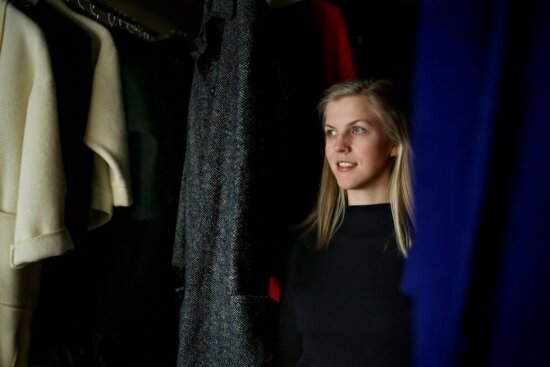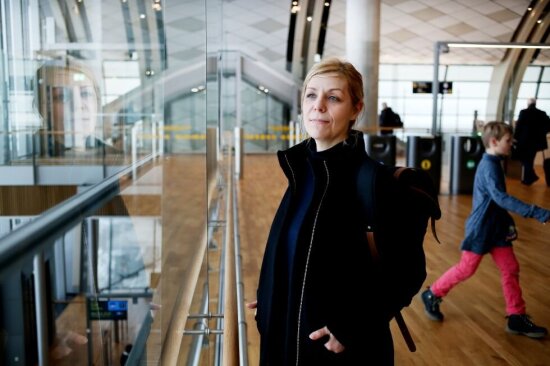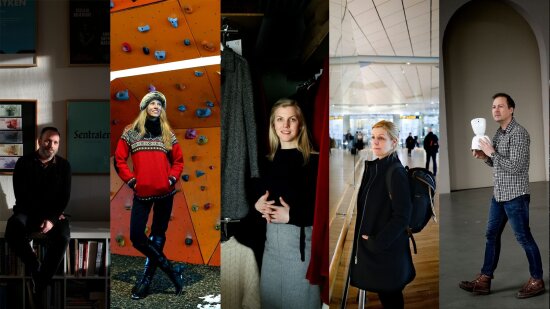
Photo: Monica Strømdahl
Asveig Marie Jellestad, Nornir
Transformed a dark underpass in Ammerud to a social meeting place for local residents.
1. Why did you become a designer?
“I love to work in the borderland between technology and creativity. So it was only natural that I studied to become an industrial designer.”
2. Of all of your designs, which one do you believe has been most successful?
“At this point, it’s hard to top the Ammerud tunnel when it comes to media coverage, but it’s incredibly rewarding to have the opportunity to help develop the Nornir brand, which plans to set its sights internationally in the smart cities theme in the course of 2017.”
3. What has been your greatest challenge in your work as a designer?
“The greatest challenge to being a designer is actually dealing with stress while being creative at the same time. The deadlines are shorter, you need to understand the client’s business model and the competition’s solutions, you need to be fully up-to-date on developments on the technology front and you need to understand users who are not able to communicate their needs.”
4. What is needed for Norway to become an internationally recognised design country?
“We need to dare to have our own visions and high-reaching goals, to pursue ideas that are created on tomorrow’s terms. Norway has every opportunity to establish itself in a niche where we can excel on the global level. Denmark, for example, is endeavouring to become the world’s first organic country. Multidisciplinary collaboration between designers and other professional groups is needed if we are to succeed.”

Photo: Monica Strømdahl
Are Kleivan, Partner and Designer at Metric Design AS
Submitted a design for the front of Norge Bank’s new banknotes.
1. Why did you become a designer?
“I became a graphic designer because I like to draw, create images and letters. When I realised as a teenager that designing an album cover, book cover or poster could be a career and that there were actually people out there who would pay me for this, it was an easy decision to become a graphic designer.”
2. Of all of your designs, which one do you believe has been most successful?
“Even if Norges Bank is not completely finished with the final design, I’m sure that the front images on the upcoming banknote series I created together with my colleague Christian Schnitler at Metric and illustrator Terje Tønnessen will be the project that has had the greatest success and reach. The entire population of Norway was the target group in this case, in addition to all of our tourists. That made it tremendously important to create clear-cut and easily understood images. It was an unusual challenge that I’m very grateful to have been a part of.”
3. What has been your greatest challenge in your work as a designer?
“I feel strongly about normalising the concept of design and that design should be as simple and everyday as possible. There continue to be quite a few myths and misunderstandings about what design actually is. It’s not intended as a vain expenditure, but an investment in a necessary means of communication. It can at times be challenging to communicate this to the people who are buying design services.”
4. What is needed for Norway to become an internationally recognised design country?
“Norwegian design has been enjoying more and more international attention. This is positive, but at the same time part of a temporary trend in which Nordic ideals and lifestyle are considered exotic. Similar tendencies can be found in food, music and other cultural expressions. I think this trend will blow over eventually and that we have to be careful not to focus too much on the design being sold or exported as ‘Norwegian’. This can result in design becoming a small niche industry from Norway. What succeeds internationally should succeed despite being Norwegian, not because of it. Our ability to adapt to the global design arena and focus on quality and broad appeal is more important than geographic location. There is a difference between ‘Norwegian design’ and ‘design from Norway’ and I am most confident about the latter.”

Photo: Monica Strømdahl
Elisabeth Stray Pedersen
Creator of locally produced and eco-friendly fashion at her factory in Drammen.
1. Why did you become a designer?
“I became a designer because I felt that the prescribed dress code during my childhood was very limited. I liked to experiment with fabrics, cuts and combinations of different clothing. I began to identify more and more with a somewhat freer way of thinking, as embraced by the magazine designers. Other than that, I’ve always enjoyed problem solving and this provides me with a deeper motivation in my work and is the reason why I am where I am today.”
2. Of all of your designs, which one do you believe has been most successful?
“I think that the entire concept and process of taking over an old clothing brand and factory with old handicraft methods and to base design on that history, but in a more modern context like Oslo Runway, has been my greatest success. It is a successful combination of a preserved legacy, knowledge and local values that is contemporary at the same time.”
3. What has been your greatest challenge in your work as a designer?
“Balancing the different aspects: the visually appealing, what sells, profitability, quality and the environmental aspect. Designing is like doing a gigantic meta puzzle: all of the pieces need to fit, but the puzzle keeps changing and you need to fit the pieces together at the right time and place. It’s challenging, but also very exciting.”
4. What is needed for Norway to become an internationally recognised design country?
“I believe that Norway needs to consider its resources and strengths and to focus on these and maintain that competence. For example, we are very good at quality assurance. We also have considerable resources and engineering strength and can contribute to combining technology and design development. Another advantage that Norway has is that we do not have rigid systems in the industry; there is plenty of opportunity to think differently and more future-oriented without getting entangled in old systems and processes.”

Vidar Pedersen, Snø Designstudio
Designed the AV1 robot that enables sick children to attend school remotely.
1. Why did you become a designer?
“My father established Råde Verktøy AS in 1968, a company that produced moulding tools for the local and national plastic industry. I grew up in this company and became interested early on in solving technical challenges linked to the production of plastic products. I’ve also always wanted to design and develop products myself.”
2. Of all of your designs, which one do you believe has been most successful?
“Together with the Norwegian company Freebit, I helped design a patented solution called C-shape for holding in-ear headsets, which has become the market standard. This universal in-ear interface solution is ergonomically developed so that the headset remains comfortably in the ear, even when running and doing other activities. The knowledge I gained about ear ergonomics has given me the opportunity to design many of the bestsellers at the leading companies in the field worldwide.”
3. What has been your greatest challenge in your work as a designer?
“The greatest challenge is meeting user needs, as well as developing products that are production-friendly, sustainable, cost-effective, innovative and that create value. It is important for designers to understand the potential market value of the product, so that it is produced in the right way using the right materials. It’s essential to stay fully up-to-date on new materials and technologies and to look for new elements that can enable the product to stand out from the competition in the market.”
4. What is needed for Norway to become an internationally recognised design country?
“Here at Snø we deliberately use our Norwegian origins in marketing and our international clients have responded positively to this. Scandinavian design has an excellent reputation abroad. But if we are to enjoy better recognition as a country, Norwegian companies need to take more and better advantage of design expertise in Norway. Companies that prioritise design in their business agenda outperform the competition by an average of 228 percent and once the Norwegian market realises this to a greater extent, we can start to become significantly larger in the international context.”

Photo: Monica Strømdahl
Synne Christiansen, EGGS Design
Designed the traveller’s experience at Oslo Airport.
1. Why did you become a designer?
“I’ve always made things. And making things entails reflecting on how those things should be used. It’s about bringing together people, things, services and technology in a way that makes sense to people.”
2. Of all of your designs, which one do you believe has been most successful?
“The most rewarding work was helping to introduce design as a method in the field of humanitarian and emergency aid through Design Without Borders. There are 65 million people displaced in the world today. The emergency aid organisations do not have enough resources to meet the needs and turn increasingly to design and innovation as tools to find new ways to make a difference.”
3. What has been your greatest challenge in your work as a designer?
“Design is about change, about solving challenges and about looking at things in new ways. Having the opportunity to improve people’s everyday lives is fun. Using design methodology to understand user needs yields new perspectives and is the seed that leads to solutions. But designers need to challenge more. They need to challenge in terms of the environment, inclusion, evening out differences, and creating business models that are sustainable in a social sense, as well as a global perspective. We need to use our expertise to create value for all.”
4. What is needed for Norway to become an internationally recognised design country?
“Norway is good at exploring the use of design methodology in new areas. The public sector in Norway, for example, was one of the first to use service design to improve its services for the public. There is plenty to communicate to an international audience. We simply need to leave the country of fjords, make our voices heard and enter the international scene in order to share experiences and results. That is what makes it particularly rewarding to work at EGGS Design, which has international ambitions.”
